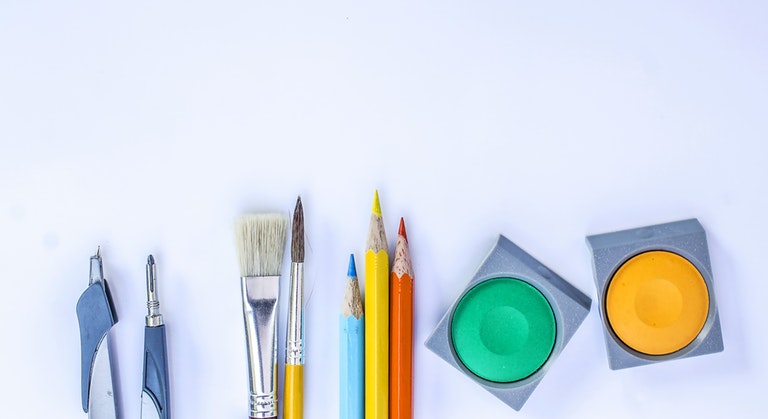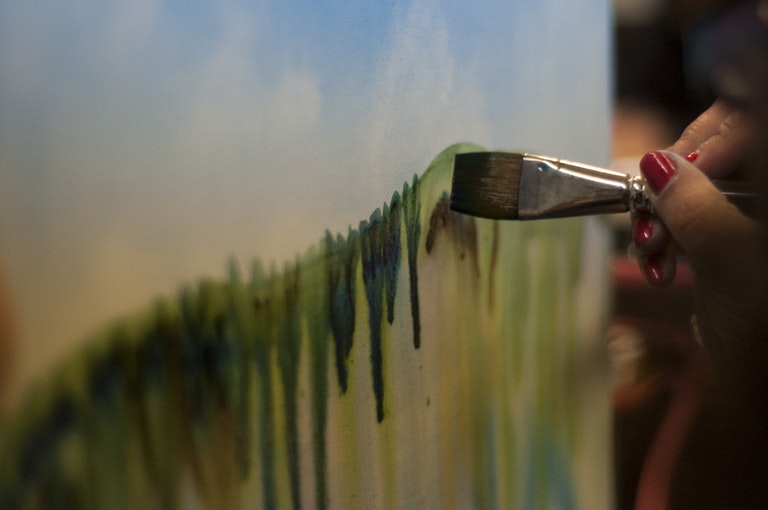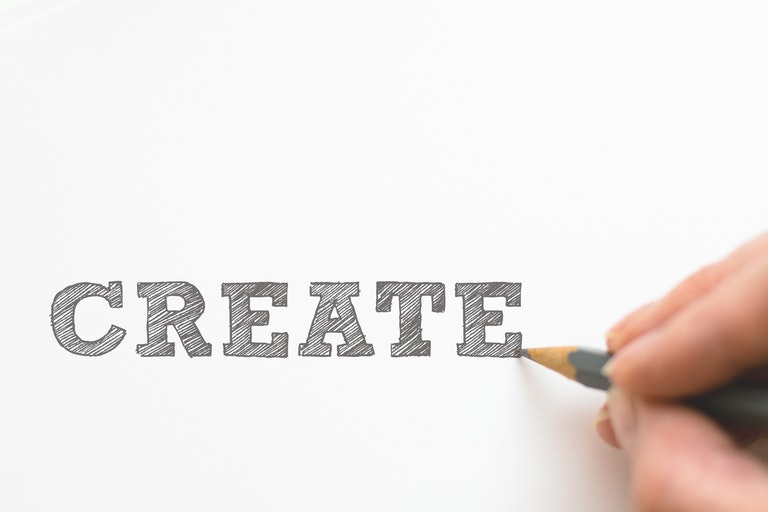Wondering how art helps teens? There are countless ways we all benefit from art-making. And adolescents are no different.

Of course, no two teens are the same and, therefore, will not experience creating art in the same way. However, they are in a particular place in development. Because of the changes happening during this stage, we can make generalizations about what is helpful. By incorporating art into ministry, you assist your students in sharing their experience and making sense of their world.
How Art Helps Teens: Understanding Their Development
How art helps teens is better understood when we first explore how they are developing. So, let’s dive into just a few of the new ways they’re experiencing life.

Teens move from concrete to abstract thinking. As children, we are concrete thinkers. Then, once we hit adolescence we can think in metaphor and hypotheticals. Additionally, we become more aware of our internal world. We can name and express what is unseen.
Because of this major shift in cognition, youth begin to feel unsure of themselves and uncertain about their place in the world. However, this is also that which makes it possible for teens to make sense of the shift through art. Thus, offering them a way to feel more stable in the midst of transformation.
Offer teens space to respond to open-ended prompts. For example, invite them to draw what they think of when they hear a particular Bible verse or how they would depict God to someone who had never heard of anything spiritual before.
Teens are doing the work of identity formation. As babies, we see ourselves as a part of everything and everyone else. As we develop as children we start to understand our separateness. Then, as adolescents, we become capable of self-reflection, which separates us from this unity that with all else we’ve always felt.
This is an important change for teens to go through that involves searching and individuation. They test out various personas and behaviors before they find the ones that feel most true to themselves. They learn who they are, what they like and don’t, how they show up in the world comfortably, what excites them and how they are unique.

How art helps teens make sense of who they are is clear when they are given opportunities for self-expression. Any creative activity that asks them to tell a part of themselves or an extension of who they are (relationships, community, home life, faith, family) will offer a venue for this. For example, provide magazines for them to create collages about their values or how they would describe themselves. Alternatively, give them time with music on to draw or paint symbols that tell about an aspect of their life.
Teens have an increased ability to think critically and make connections. Although this ability doesn’t become fully functional until we are in our mid-twenties, teens are beginning to see the world in a more complex way. By the time we reach high school, we can understand the ways systems are at work, for example. From our family system to our solar system, we have a broader sense of the interdependent nature of all things.
As youth begin to see in more complex ways how their world works, they often begin to feel a sense of injustice and frustration. Part of their journey of maturation is noticing painful things that need to change. Although this is difficult, it also creates passion and motivation to take initiative. This can take several forms. From one’s own family to one’s own nation. Look at the teens leading the fight against gun violence as just one example!
Amidst this increased awareness, one way of offering youth a space to make sense of it concretely is through art. One way of doing this is by inviting them to draw their feelings and then discuss them. Alternatively, youth can create art around a single topic they see in their own community that needs addressing. Then, invite them to discuss ways they feel called by God to respond to the systemic pain together.

Why Art?
There are several ways teens make sense of their world. They need different avenues for expression in order to find their way. But art is a unique gift to them.
First, art allows for absolute personal preference to reign supreme. Youth are given the freedom to create what they want to. So many young people are plagued by peer pressure as well as familial expectations. Art can be a way for them to find themselves without the weight of what they assume others want from them.
Second, art helps what is not yet or may never be processed verbally to still have expression. For teens especially, there is much they’re experiencing for which they don’t yet have language. However, they need to have some way of getting what is internal out. Art offers that to them.

Third, art is intuitive and is neither right nor wrong. This is helpful for them in their own development of self and valuing their own preferences. Additionally, in a world that becomes increasingly polarized, encouraging people to identify with rigid perspectives, art gives youth a way of experiencing the multiplicity of truth.
Fourth, art is something that we often let go of early in our lives. We were likely told at some point that we weren’t good at it, and we then gave it up. So, when teens begin making art they recover parts of themselves they haven’t visited for a long time. Reliving our own experiences of childhood can bring about an openness to hope and creativity, the divinity that is in all and through all, that we sometimes lose sight of as we age.
We hope this has given you some renewed or newfound excitement around the use of art in your ministry. If you’re looking for an easy way to explore art with your youth, check out our coloring posters. And we’d love to hear from you. So, don’t forget to share in the comments below how your faith community is incorporating art!


Joan Jones says
We love Illustrated Children’s Ministry! Our church family looks forward to seeing what we have out on Sunday mornings to color! We have begun framing the coloring posters and hanging them throughout our building! Thank you, ICM, for enhancing our education and worship!
Stephanie Menicanin says
i love the look of these.
Alissa Ellett says
We’re so happy to hear this, Joan! A beautiful and engaging space brings us closer to God, and we’re honored to take part in that with your faith family!
Janet Chambers says
Thank you for this wonderful article! Amen! I have been teaching art for years with children and find it very rewarding to watch their creativity shine through and open doors for them. It is an important spiritual tool in helping them see where they are at and where they are going. They love creating God’s beautiful world.
Alissa Ellett says
How great, Janet! So thrilled to hear this. You’re doing amazing work in their lives.
Joy Crosher says
We used the Lent Psalm colouring sheets and an older gentleman from our church was delighted to use them and brought them back to church for us to put up. It enables us to connect with him in a meaningful way and him to have great pleasure.
Alissa Ellett says
Joy, how wonderful! Thanks for sharing that with us!